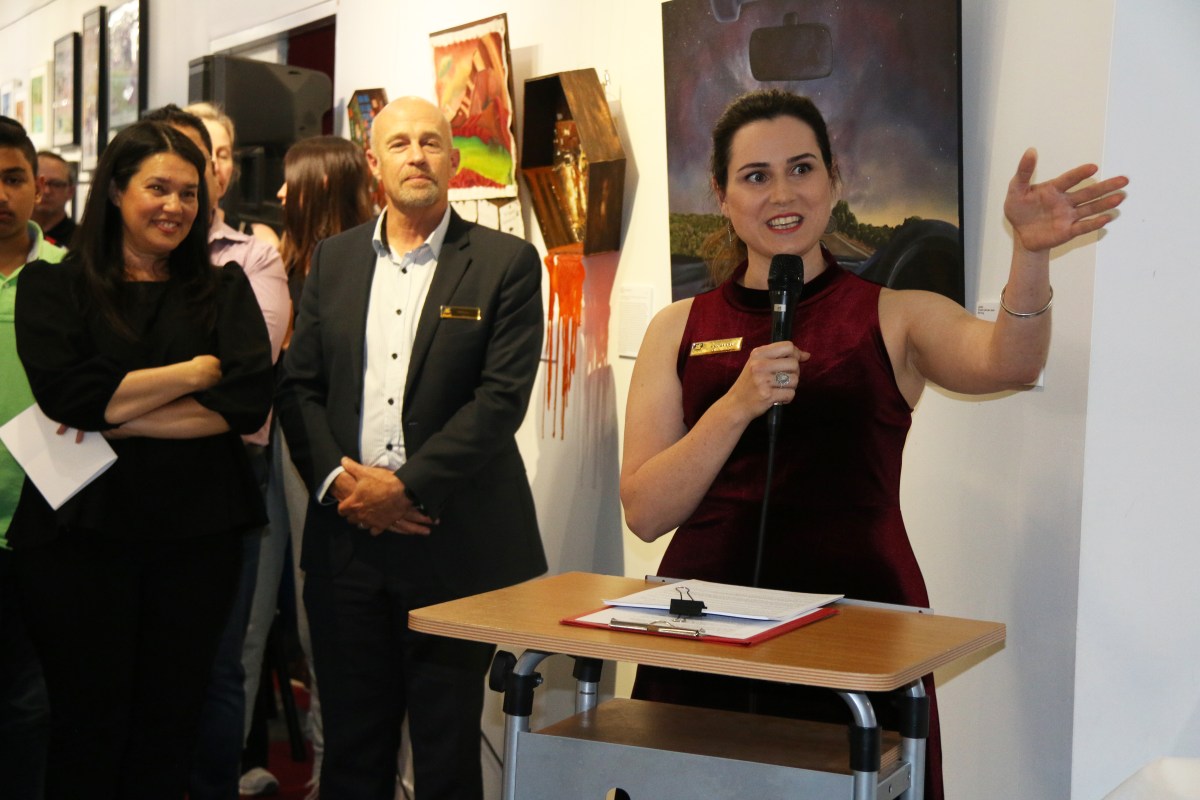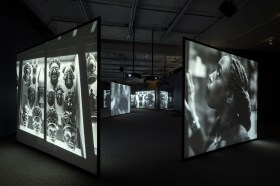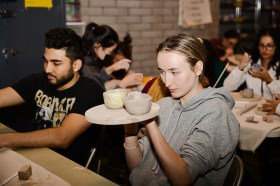Fulfilling and financially sustainable careers absolutely do exist for high school students who excel in the visual arts, says Sarah Eve, an award-winning teacher and visual artist with special expertise in gifted and talented education. But – and here’s the “big but”, according to Eve – students and, most importantly, their parents, don’t know these careers exist, or which study pathways may lead to them.
‘Students and parents often perceive an art career solely through the archetype of a struggling artist, instead of seeing a thriving industry and a rewarding career that contributes to society,’ Eve tells ArtsHub. ‘More arts educators need to take an active role in advocating for visual arts careers to students, parents and the wider community – and there are so many opportunities to do so.’
Currently teaching at Perth Modern, which is the singular selective public school for academically high-achieving and gifted students in Western Australia, Eve is passionate about challenging negative stereotypes and misperceptions, and opening up the eyes of students to the broad and varied careers that are available beyond being that “starving artist” or the artist-turned-art teacher.
A member of the Community of Practice for Educators with the arts advocacy organisation NAVA, Eve received a National Excellence in Teaching Award in 2019. Over the years she has worked on the School Curriculum and Standards Authority, and a teacher encouraged students to explore various career pathways. It’s that work she’s keen to talk about because she sees its lack.
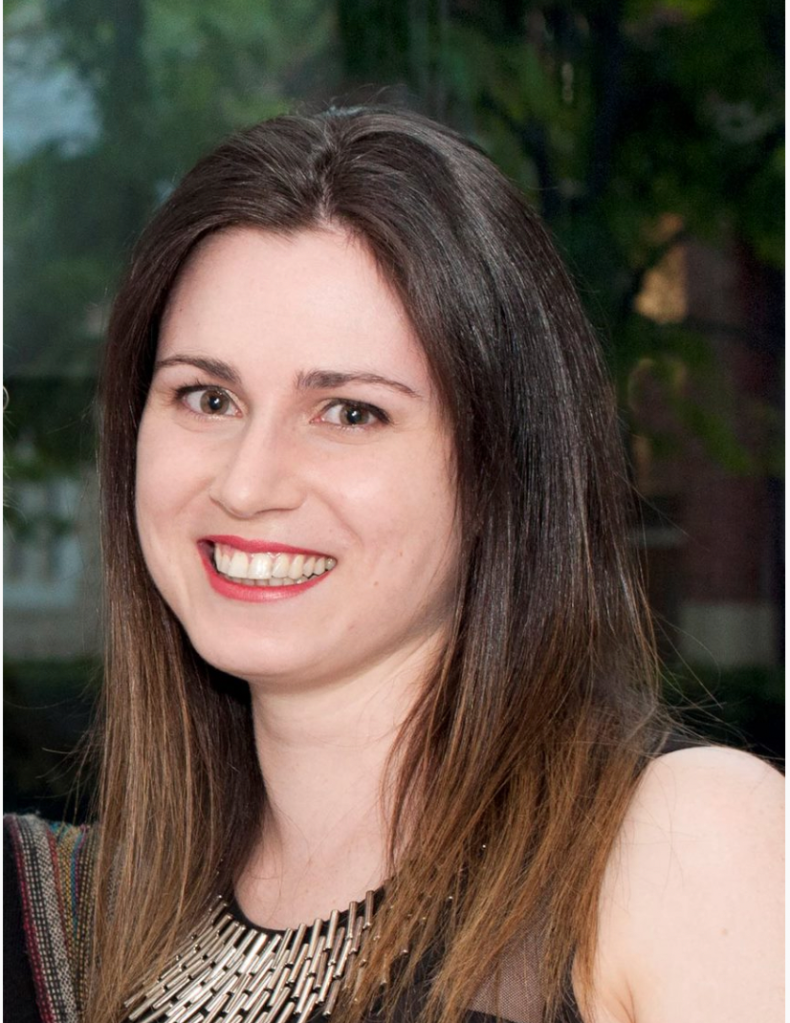
‘My experience in specifically educating young people about visual arts careers in high school is quite limited,’ says Eve. ‘I have attended various career expos where universities and other organisations present stalls to discuss their offerings with students. However, there is a noticeable absence of advocates for visual arts careers at these events.
‘Unfortunately, many school’s career officers lack education themselves in the arts, and tend to dissuade students from pursuing art, citing concerns about the time it takes and the perceived lack of a viable career path. Instead of recognising a student’s passion for the arts, they often steer them away, reinforcing negative stereotypes about art careers.’
While acknowledging some of the wonderful programs that exist, Eve says she’d like everyone in the creative industries to get more involved in this project of careers education. She sees this as essential if we are to retain the next generation of artists – young people who may be pressured to choose and specialise in more “sensible” academic subjects in their final years of high school, for lack of information or imagination.
‘More arts educators need to take an active role in advocating for visual arts careers to students, parents and the wider community,’ says Eve. ‘Educators should engage in dialogue, offering statistics on how arts education can lead to tertiary interests and related career opportunities. Initiatives like artist visitor programs, gallery mentor programs and careers expos further broaden students’ horizons.’
Read: 20 creative habits to kickstart a productive day
Careers education in the visual arts classroom
Earlier this year, Eve gave a well-received presentation and workshop, ‘Advocating for Visual Arts Careers’ at the 2024 National Visual Art Education Conference (NVAEC) held at the National Gallery of Australia (NGA) in Canberra.
In this workshop, she offered participants – fellow visual art teachers and educators – an opportunity to explore ways to incorporate careers information into the curriculum at various levels and age groups. She shared her personal collection of classroom activities and resources, and explained how she used AI to assist in their creation.
Eve is keen to freely share this presentation and the activities with other educators. She says they’re designed to explore and demonstrate how art can be significant, enjoyable and a viable career option that meaningfully contributes to society, often in professions or jobs that may not at first seem “artsy”.
An example of one of the classroom activities is given here:
Y9- A3 diary page/A4 drawing/poster, select one of the following arts jobs and answer the following:
- Create a small A4 drawing in the style of the artist job role.
- What is the job description/career opportunities in the world?
- How does this visual arts job contribute to people/society?
- Does this job have benefits/flexible hours/ travel opportunities?
- Find real life role models of people in these jobs and describe some specific examples of their work.
- Find a current job advertisement of this job role to provide more information. Look online at ArtsHub Jobs or Seek.
- Why did you select this arts job role to explore?
You will present your drawing/visual diary page in small groups.
Arts jobs to explore: journalist | courtroom sketch artist | cinematographer | set designer | metal fabricator | 3D modeller | layout artist | visual effects artist | set designer | special effects | motions graphic designer | print designer | industrial designer | materials engineer | graphic designer | scientific documentary filmmaker | video game designer
Slides from the presentation show how art and career research can come together and expand a student’s sense of possibility.
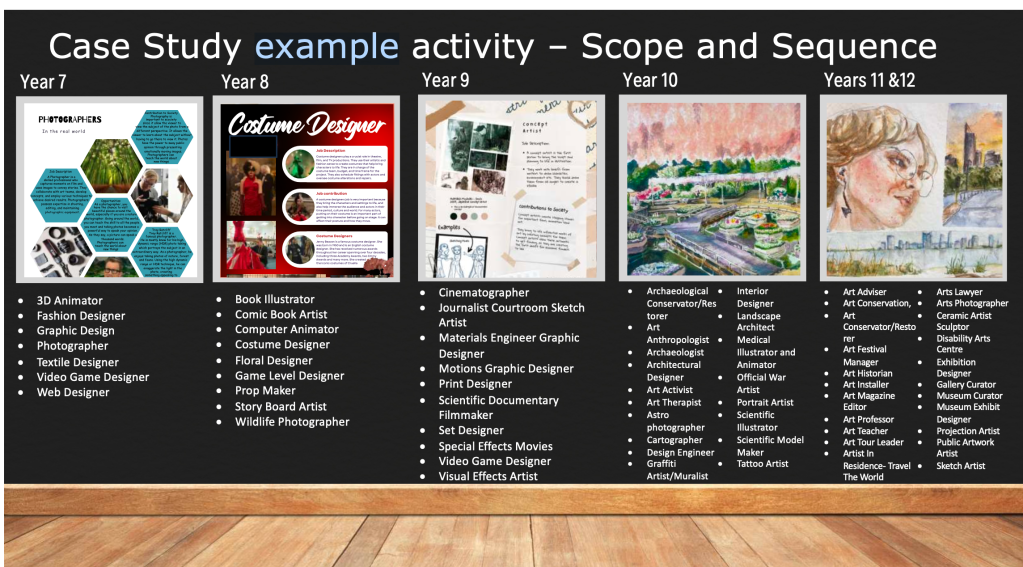
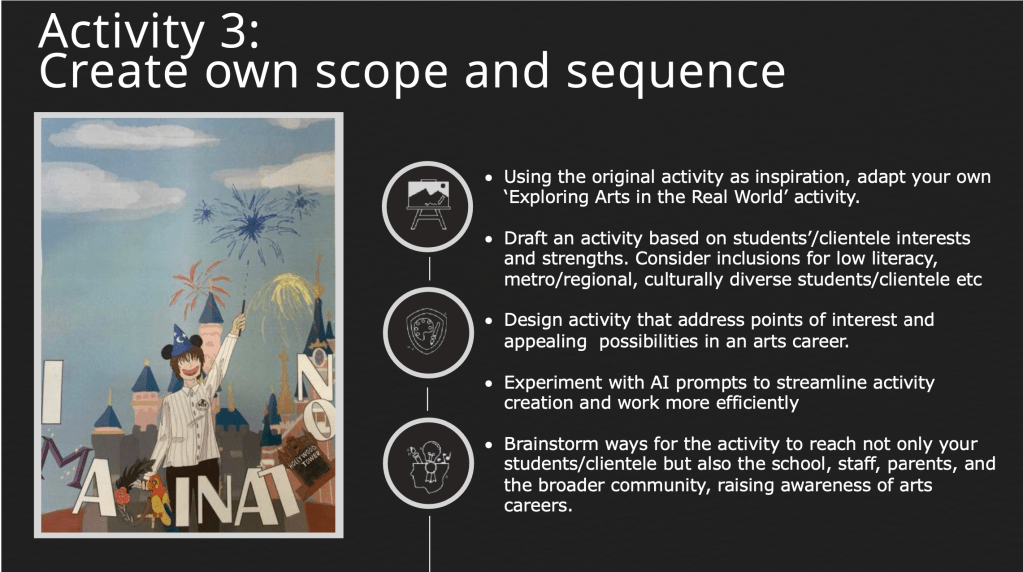
Obstacles and presumptions
Eve gives a detailed list of the presumptions, concerns or obstacles that currently impede students from exploring a career in the field of art. These include:
- Traditional job markets often undervalue arts careers, leading to a perception of compromise in pursuing them.
- The arts sector is seen as highly competitive, with a lack of clear information on career options and pay scales.
- A “black box” secrecy surrounding the art world’s inner workings contributes to its mysterious perception.
- The prevalence of the gig economy in the arts raises concerns about stable employment and financial viability.
- Students harbour fears of insufficient talent or job opportunities, particularly in specialised fields like archaeology, gallery curation or design.
- Parents often consider the arts a financially risky and non-viable career path, akin to a hobby rather than a profession.
- Common misconceptions about the need for traditional art skills obscure awareness of the field’s diverse career opportunities.
- The unclear and dynamic nature of arts career pathways causes confusion about entry and success in the industry.
- Presumptions that creative careers don’t align with traditional full-time roles mean people overlook the sector’s diverse job possibilities.
- Beliefs about the lack of financial reward in the arts, along with doubts over the relevance of art qualifications for business, deter student interest.
- The invisibility of creative professionals within organisations adds to the elusive perception of the artist’s career path.
- Arts job advertising methods, differing significantly from those in common professions, reduce their visibility to potential candidates.
- Limited community exposure to real-life artists and parental knowledge gaps reinforce the idea that creative subjects don’t lead to successful careers.
- Concerns about low, unstable and unsteady income, plus scarce job opportunities, form a significant barrier for students considering arts careers.
- Critics argue that career advancement in the arts is slow and challenging, dependent on external factors like market trends and networking.
- The subjectivity of success in the arts makes it challenging to measure, leading to frustration and feelings of rejection.
- Traditional arts careers often lack benefits like health insurance and retirement plans, adding to concerns about stability and security.
Eve says it’s important that we challenge these narratives with better and more nuanced information, and a more positive approach.
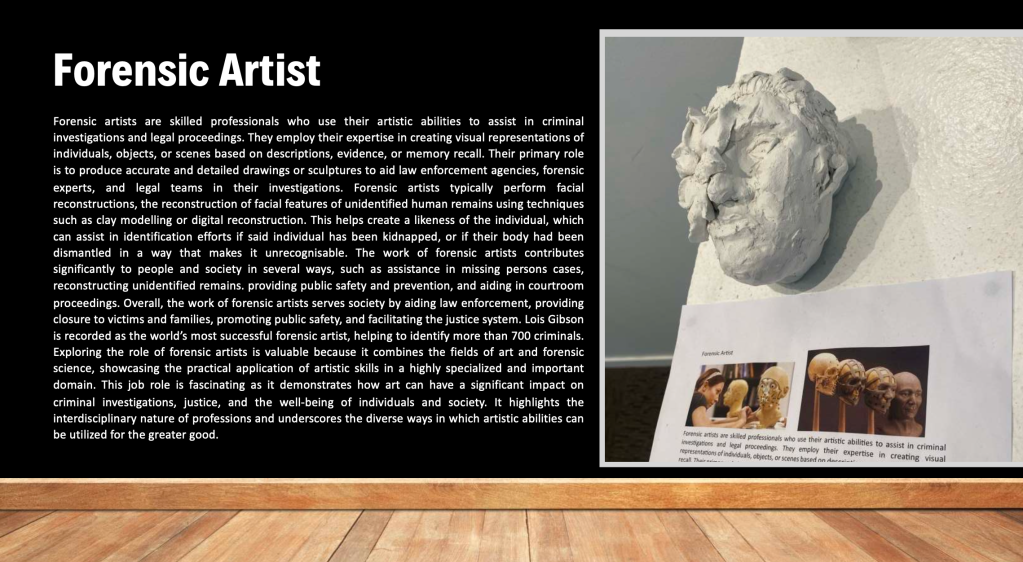
Read: The Artist’s Way: an invitation to change your life
Creating more positive narratives about careers in visual arts
‘Students should be encouraged to believe in themselves and create their opportunities,’ says Eve. They need examples of how art intersects with major ideas, issues and history. This could include providing opportunities to work with artists who have diverse careers, such as curators, educators and conservators, and including them in educational talks and career expos.
‘It’s crucial to share narratives that showcase the flexibility of moving between similar or vastly different industries, emphasising that art is more than creating artworks – it encompasses creative thinking and problem-solving skills applicable to daily life, in fields like TV, fashion, architecture, design, music and writing. This perspective is essential for students to understand the broader applications of art, and doing so reinforces its value in education.’
Ideas and opportunities for advocating for the visual arts
Eve would like to see a concerted effort from everyone involved in the arts to help young people with career information and opportunities – whether that’s in sharing practical insights, taking on work experience students or just talking more about the diverse careers that emerge over a lifetime.
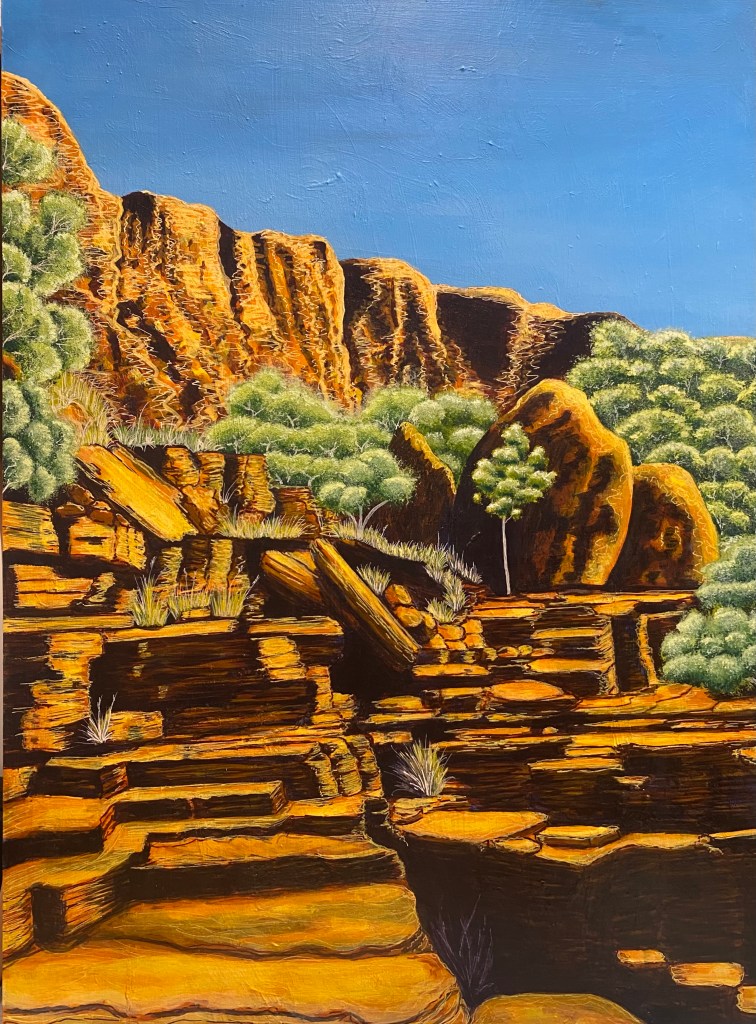
A visual artist herself, with a renewed personal practice, Eve is inspired by the natural landscape. She believes deeply in the value of creative expression – both in life and in teaching – and in the importance of building confidence and a sense of possibility and hope for young artists.
Eve wants us to think outside the box when it comes to whose job it may be to inspire and inform students about potential careers. Here is just a part of her list of suggestions for who and what visual arts careers advocacy could involve:
- Visual arts staff members can actively promote careers in the arts to students.
- Artist practitioners can contribute to classroom programs, offering real-world perspectives.
- Guest speakers, professionals from the arts industry, can share insights and experiences.
- Art exhibitions and galleries can serve as practical platforms for showcasing careers in the visual arts.
- Education and career guidance teachers, appointed by schools, can specifically address career possibilities.
- Excursions and external programs.
- Adults in the school community, including teachers and parents, can engage in discussions about the value and opportunities of visual arts careers.
- Visiting artists and collaborations with institutions like the Phoenix Art Gallery, through mentorship programs, can provide practical insights.
- Events like careers expos open avenues for exploring various art-related professions.
- The National Summer Arts Scholarship for Year 10 students showcases the integration of arts with technology, film and fashion.
- Open days, bridging programs and short course opportunities offer glimpses into visual arts careers.
- Partnerships with educational institutions like TAFE enrich learning experiences.
- Videos featuring local artists sharing their career journeys can serve as inspirational resources.
